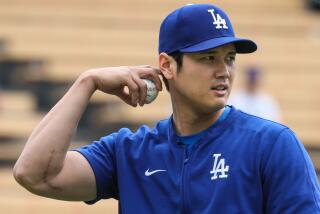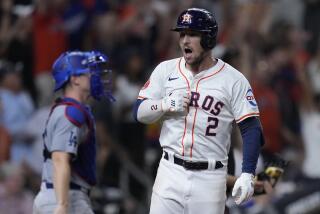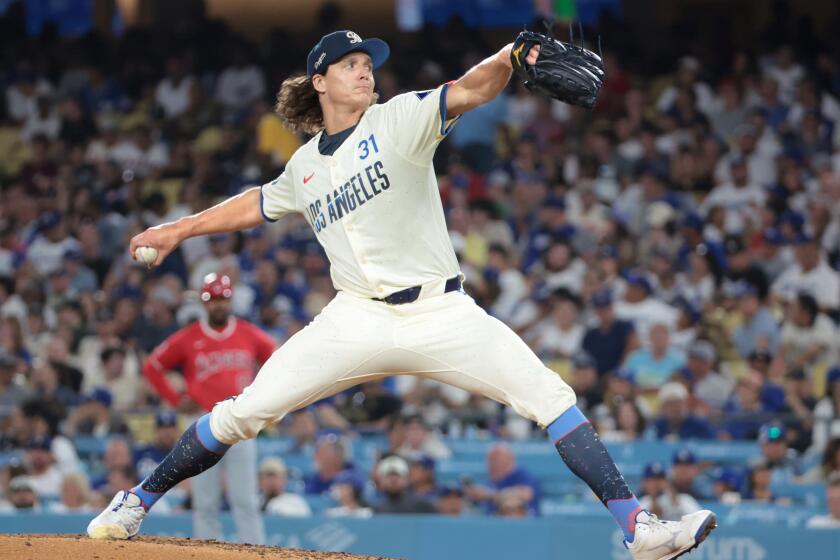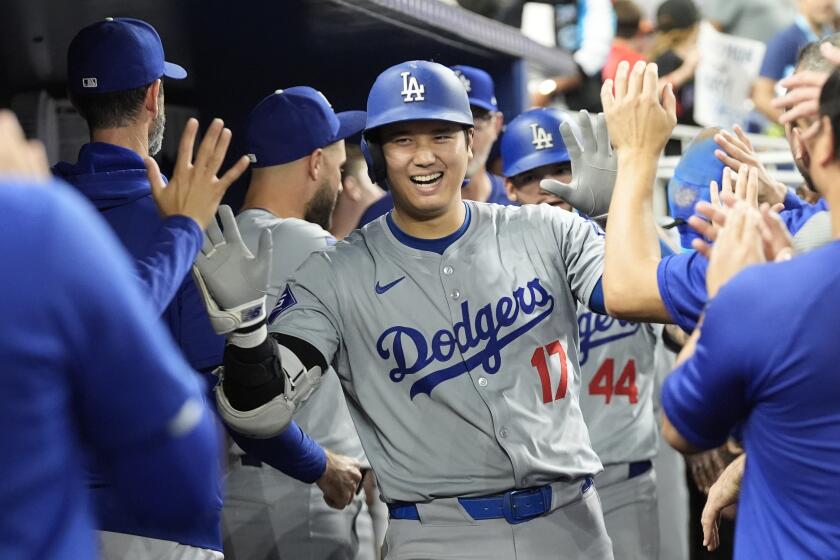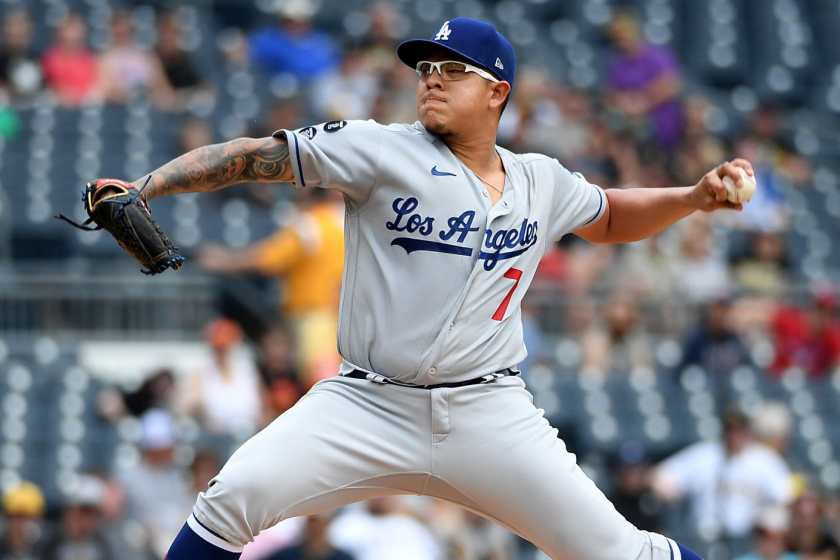Dodgers Dugout: A statistical look at the bullpen; Joe Davis answers your questions
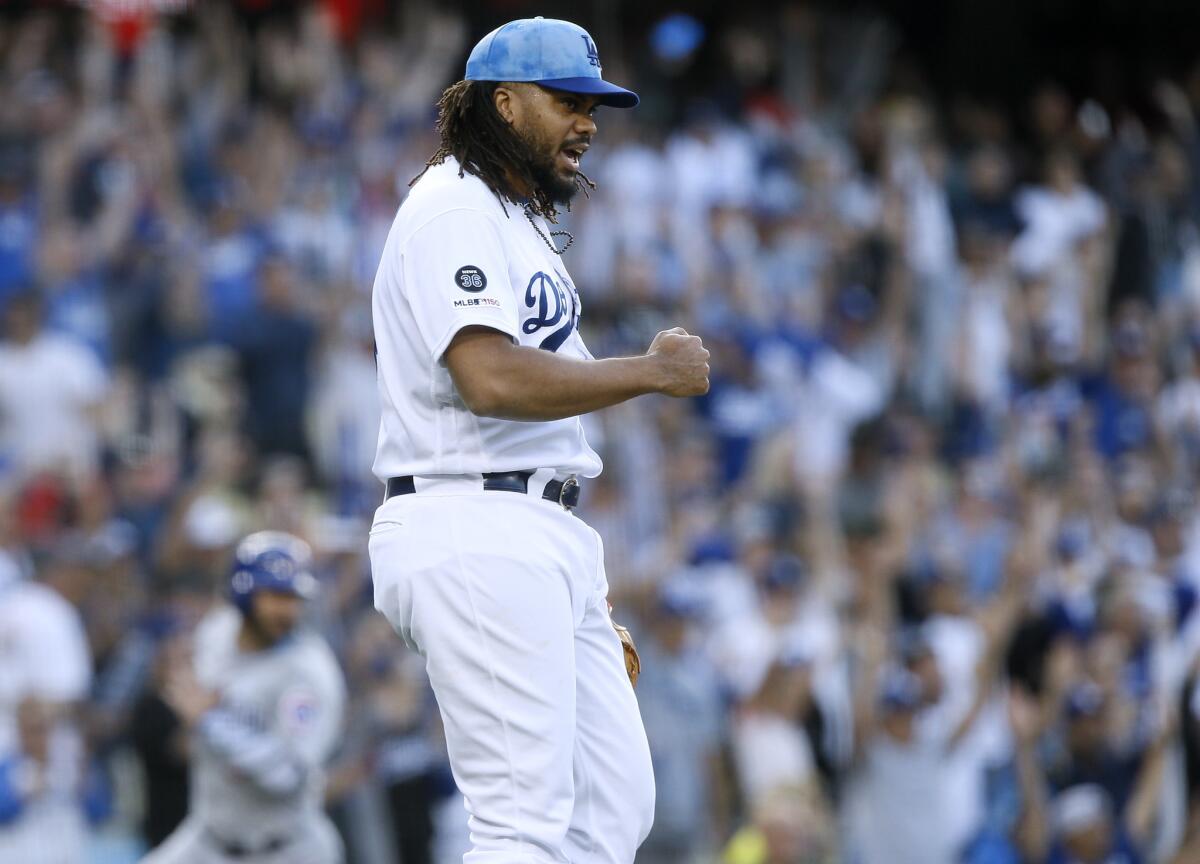
Hi, and welcome to another edition of Dodgers Dugout. My name is Houston Mitchell and may the family and friends of Tyler Skaggs find peace in the upcoming days.
A closer look at the bullpen
Let’s be honest about this season: Barring unforeseen injuries to some major players, the Dodgers are going to win the NL West. They are clearly the best team in the division. And that’s great. But this leaves a big problem for Dodger fans. Without the excitement of a close division race to distract us, all we can focus on is “What happens when the playoffs begin?” And that leads us to think about the last two years and losing in the World Series. And that leads us to think about the bullpen.
Which makes us look at this year’s bullpen, which is worse than the bullpen of the last two seasons. And that leads us to think that this whole thing is a wasted effort, since they can’t possibly win the World Series with this current bullpen. It’s a vicious circle.
As your humble newsletter writer, I don’t want to focus every newsletter on the bullpen. We know it is the Achilles’ heel of the team, but it will also become quickly boring if all I do is criticize a team that has the best record in baseball.
The fact is that the Dodgers need to acquire someone before the trade deadline. We took a look at candidates last time. This time, we are going to take a look at the current bullpen, then I’m going to set the bullpen aside for a few newsletters and focus on other aspects of the team. Not because I don’t think the bullpen is a problem, but because other areas deserve attention, too.
We did the following statistical look about 40 games into the season. We’ll examine the numbers again now that we are about 80 games into the season.
Let’s look at the ERA+ for the bullpen. ERA+ compares a player’s ERA to the league average, with an adjustment for their home stadium. A 100 ERA+ is league average, 110 ERA+ is 10% better than average, 90 ERA+ is 10% worse. You get the idea.
Gotten better since 40-game mark
Julio Urias, 168 (129 before)
Ross Stripling, 137 (127)
Kenley Jansen, 136 (94)
Pedro Baez, 147 (127)
Joe Kelly, 68 (47)
Gotten worse since 40-game mark
Scott Alexander, 117 (147 before)
Yimi Garcia, 100 (105)
Dylan Floro, 92 (had not allowed an earned run last time)
Caleb Ferguson, 77 (120)
The Dodgers also employ JT Chargois and Zac Rosscup in the bullpen, but they haven’t pitched enough for their numbers to mean a lot.
Of course, ERA+ isn’t entirely accurate for relievers because a reliever’s ERA gives only a small glimpse at how well they have pitched. As I’ve said before, a reliever can come in with a man on base, give up two singles to score that runner, then get the last out. He has an ERA of 0.00, but did he really pitch well? No.
For relievers, a good stat to look at is IRS%, which is short for inherited runners who score percentage. It’s also shortened as IS% on some websites. This tells us how effective the reliever was when he came in with runners on base. Come in with the bases loaded and hold them scoreless, then your IRS% is 0%. Allow all three to score, and it is 100%. Two of three? 66.7%. You get the idea. The lower number the better.
The league average in IRS% this season is 32%. Let’s see how the Dodgers relievers are doing compared to that.
Better than league average
Pedro Baez, 25% (23.1% last time)
Worse than league average
Yimi Garcia, 33.3% (40%)
Dylan Floro, 36.4% (41.2%)
Kenley Jansen, 41.7% (66.7%)
Scott Alexander, 55.6% (41.7%)
Joe Kelly, 60% (60%)
Caleb Ferguson, 66.7% (66.7%)
Ross Stripling and Julio Urias have not come into a game with runners on base, so they have no IRS%.
So, the Dodgers bullpen has been pretty bad this season at coming into games with runners on base and escaping the inning.
OK, let’s look at one more area and then we will end the stat analysis. Let’s look at Wins Above Average. This basically takes the WAA earned by every player who played that position for the team, combines them, then compares that number to every other team. Where do the Dodgers rank at relief?
Relief pitcher: -3.5 (12th). Last time: -2.7 (15th)
So, we can confirm what we already sense: The bullpen is bad. Help is needed. Let’s hope the front office has a trade in mind.
I end this with my usual caveat: There is no one stat that gives you a complete picture of a player. But every stat is useful in its own way, some more than others. I encourage you to visit sites such as baseball-reference.com and take a look at all the numbers yourself.
Ask Joe Davis
Dodgers broadcaster Joe Davis has answered many of the questions you sent in and they appear below. I got hundreds of them, so my apologies if your question was not answered. Some questions were asked by multiple people, so I used the name of the first person to ask the question. And I thank Joe for taking time out of his schedule to talk to Dodgers fans. I highly recommend you follow him on Twitter, he interacts with followers there often.
Evelyn Fisher: I really miss you when you are not broadcasting with Orel. What are you doing when you are not our announcer?
Joe: I do games nationally for FOX Sports as well. Actually had that job before adding the Dodger job. I promise I’m never just sitting at home instead of doing a Dodger game. I also promise I watch closely while I’m gone and get almost sick to my stomach when special things happen in the Dodger game and I’m not there for it. Serious “FOMO” as the kids call it!
Seth Sutherland: Is there a way we can find out in advance what Dodgers games you are going to miss?
Joe: Best way I can explain is I do FOX MLB games most Saturdays from roughly late May through mid-July, with a couple sprinkled in in the second half as well.
Thankfully, this year, many of those FOX MLB games are Dodger games and don’t force me to leave for the weekend. Same idea once college football begins.
Jason Hashmi: Being so close to the team all season, both during the games and behind the scenes, what is the one thing you think fans don’t know about this team but should?
Joe: I know I’m always curious to know if the stars we watch from afar are at the core good, normal people. And I can tell you that this group has as many good, normal people as any team I’ve been around.
Ron Rand: In what ways did you prepare yourself to follow Vin Scully in your excellent announcing and also still be “yourself?”
Joe: You used a key word in your question: “follow,” as opposed to “replace.” That’s how I approached it from the start, and I think that would’ve been the only way to go about it. Vin was the greatest ever to do it. I think human nature could lead you to try to be just like him — heck, why wouldn’t you want to copy the greatest ever? — but there’s a fine line between learning from what made him the greatest ever and trying to copy him. Along these lines, Vin’s biggest piece of advice to me when I started was to be myself. Same advice Red Barber gave him in 1950. I try to incorporate things that made Vin so spectacular, while at the same time allowing myself to be myself.
Fabian Valdez: I have been a Dodger for 50 years. You and Orel are great, I really enjoy you guys. When did you know this is what you wanted to do?
Joe: A long long time ago. Hard to put an exact age or story to when I first knew, but I know I’ve been paying close attention to the guys calling the games since probably middle school. I used to announce my video games and my imaginary games in the backyard. It’s all I’ve ever dreamed of doing. I often pinch myself thinking about the fact that this is all real.
Richard Hood: What is your typical day like when you’re traveling with the Dodgers. How many hours are you online to read baseball news and do research, etc.?
Joe: The baseball day tends to start a little later since it also ends so late most nights. I try to get as close to 8 hours of sleep as I can, but also try to be up before 8. I work out in the hotel gym, shower, then breakfast. I’m a big breakfast guy. This is one of my favorite times of the day. Workout finished, day ahead. It’s where I begin my prep for that night, too (actually I prep the next day’s starting pitchers before I go to bed each night, but you get the idea). I think I probably spend roughly three hours during the day studying and reading up for that night. Less some days, more other days (especially at the start of a new series). There are a couple of buses each day from the hotel to the stadium. I usually take the early bus, which puts me at the park 4-4.5 hours before. Sometimes I’ll decide to continue to work at the hotel and take the late bus instead (arriving about 3 hours pre-game).
Once at the park, it’s a matter of going through the materials each team prints out each night (game notes, stat packs, etc.) and highlighting what I need. I transfer that stuff (and the things I spent the day researching/collecting) to my scorecard. I get to the field for batting practice. Dinner. Makeup. Change from polo shirt to shirt and tie. Final review of graphics/pre-packaged tape pieces/etc., final prep, and before you know it, it’s game time.
Andrew Jacobs: You clearly have a lot of research and general work to do before each game. In that context, what is the toughest aspect of a game to prepare for and why?
Joe: I don’t know about “tough” (I’m reading about baseball — that’s not tough), but the most time-consuming thing is the prep that goes into a new series, especially when seeing that team for the first time that year. I spend an hour or two on each opposing player in the week or two leading up to the series, gathering every story I can find (while understanding only a fraction of what I find is going to actually get told that series; you prep for everything but let the game dictate what/how much you tell). And then the added hours once the series arrives making sure I’m up-to-date on all the story lines of that team. With baseball being an everyday sport, those story lines can change so quickly. I’m OCD on this — I have a hard time if I feel like there’s something out there that I haven’t taken the time to know.
In terms of “toughest,” I suppose the most challenging thing is finding fresh material on our own guys. Since we’re covering the Dodgers every day, it’s a challenge to not get stale, and I’m always mindful of not recycling stories too much (although it’s bound to happen some — it’s a long season.)
Manuel Dominguez: Why do they call a 3-2 pitch the payoff pitch?
I asked my friend Jesse Goldberg-Strassler, the author of The Baseball Thesaurus, if there was any fun backstory to this, but it sounds like it’s as simple as it’d seem: the word “payoff” is defined as “the result of a set of actions,” and since the AB is going to end sooner rather than later when the count is 3-2, that pitch is considered the “payoff pitch.”
That one wound up not being too exciting, but check out Jesse’s book if the etymology of baseball terms interests you.
Toyo Kimura: With all the traveling and having to deal with abnormal schedules and different time zones, what are your travel hacks to make sure you get a good night’s sleep, eat healthy, and stay energized?
Joe: I think a big thing is making all those things a priority. I try to get as close to eight hours of sleep as I can while on the road (kids ensure that aint happening at home). Eating healthy is pretty easy to do during the day, although at night we’re kind of at the mercy of what the press dining room has for us pregame. Thankfully, most press dining rooms have a salad bar as a fallback. Finding a way to get a workout in is key. Even the days where it’s a tight squeeze (day game after a night game, for example), I try hard to at least do a quick bodyweight workout in the room. Doing those things above definitely helps energy levels, but I’m also a big coffee guy and not a day goes by where I don’t have one or two Zipfizz (basically a daily vitamin/B12/caffeine powder that’s simply dropped in 16oz of water. My doctor recommended it to me).
Steve Fuller: You have stepped in seemingly seamless as Vinny’s successor. Was it difficult to take over for a legend?
Joe: Thanks, Steve. Difficult in the sense that I viewed it as an extremely important responsibility to be the guy that came after Vin; Dodger fans had listened to nothing other than the greatest broadcaster of all time for the entirety of the team’s existence in LA. But as I mentioned above, I wouldn’t have had much hope if I had put pressure on myself to replace him. I’ve just tried to be me. And this is a huge thing — the team on the field has been amazing. I’m so very lucky that all three seasons I’ve been in that chair, the news I’ve been delivering has been mostly good. If they’d averaged 100 losses in the few years after I took over, I might’ve been run out of town by now.
Lance Ballesteros: I follow you on Twitter and see you are a fan of grilling. What are some basic mistakes to avoid?
Don’t cook to time, cook to temperature (and feel). Don’t over-season, especially beef. Let the taste of the meat shine through.
All-Stars
The Dodgers will have four players representing the team at this year’s All-Star game: Cody Bellinger, Walker Buehler, Clayton Kershaw and Hyun-Jin Ryu. A lot of Dodger fans are unhappy that Max Muncy was left off the team. Frankly, I don’t think it matters that much. Sure, it’s a nice honor for the player, but as a fan, I stopped caring about the All-Star game around the time every game was on TV somewhere. The All-Star game used to be the only place to see players like Willie Stargell or Mike Schmidt or Rod Carew or Johnny Bench. Now you see the big stars every day, either because their games are on TV or their highlights are all over social media and ESPN.
Besides, Muncy could still make the team if another player gets hurt or withdraws. And if he doesn’t, he might benefit from the four days off. You never know.
Where’s Ned?
Many of you have asked me what happened to Ned Colletti on the Spectrum Sportsnet pre-game and post-game Dodgers shows. Never fear. He is fine and will be back this month.
These names seem familiar
Here’s how players who were with the Dodgers last season and earlier this season are doing around the majors this year (through Sunday):
Travis d’Arnaud, Rays, .235/.286/.431, 89 OPS+
Brian Dozier, Nationals, .230/.309/.424, 86 OPS+
Kyle Farmer, Reds, .242/.290/.455, 87 OPS+
Logan Forsythe, Rangers, .259/.360/.402, 97 OPS+
Yasmani Grandal, Brewers, .265/.376/.531, 132 OPS+
Daniel Hudson, Blue Jays, 5-2, 2.92 ERA, 1 save
Tim Locastro, Diamondbacks, .245/.380/.327, 87 OPS+.
Matt Kemp, Mets, .200/.210/.283, 28 OPS+. Still recovering from broken rib.
Manny Machado, Padres, .277/.352/.516, 130 OPS+
Yasiel Puig, Reds, .239/.290/.458, 88 OPS+
Alex Wood, Reds, on IL with sore back. Out until at least the All-Star break.
Up next
Tonight: Arizona (Taylor Clarke) at Dodgers (Ross Stripling), 7 p.m.
Wednesday: Arizona (Merrill Kelly) at Dodgers (Walker Buehler), 7 p.m.
* Left-hander
And finally
Vin Scully calls the final inning of Sandy Koufax’s perfect game. Listen to it here.
Have a comment or something you’d like to see in a future Dodgers newsletter? Email me and follow me on Twitter: @latimeshouston.
More to Read
Are you a true-blue fan?
Get our Dodgers Dugout newsletter for insights, news and much more.
You may occasionally receive promotional content from the Los Angeles Times.


